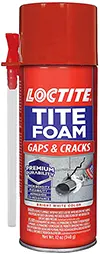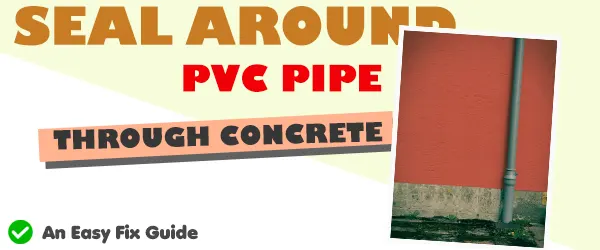My friend Jimmy wants to install a 6″ PVC sewage drainage pipe through his concrete foundation wall.
What he did, was dig a 10″ hole in the concrete wall to slide an 8″ PVC pipe. He wanted to use this pipe as a sleeve pipe to support the 6″ PVC pipe. If there are chances for damage due to the shrink or expansion of the concrete then the 8″ sleeve pipe will prevent any damage to the main drainage PVC pipe.
But…
He is wondering about how to seal PVC pipe through the concrete wall.
A PVC pipe is a great way to add additional utility to a space, but it can be a real pain to get a good seal around the pipe. The problem is that when you drill a hole in the concrete, you’re also creating a potential leak point.
If you don’t seal the hole, water will seep in, which can cause all sorts of problems. Small holes and gaps around pipes are easy pathways for mice, rodents, and pests. It can also make the concrete look really bad. But don’t worry, we’ve got you covered!
We’ll show you how to seal around a PVC pipe through concrete using some simple, effective techniques that will keep water from leaking into the concrete.
Table of Contents
Some Easy Ways To Seal Around PVC Pipe Through Concrete
You have to seal PVC pipe inside and outside of your home and you need different materials in each case.
1. Seal The Gap Between PVC Pipe And Concrete Wall Inside Your House
To seal the gap around the PVC pipe you need to follow these steps:
Step 1: Clean The Surface Properly
Before sealing the gap, you need to clean all the dust and debris from the surface. You need to use a dry cloth to clean it. You can also use a vacuum cleaner to clean the surface. Make sure that you clean the surface thoroughly.
Sometimes your vacuum cleaner is unable to reach those hidden points. To clean them you can use a simple trick. Just attach a small tube to the vacuum cleaner hose and secure it using a tap. This way you are able to clean the whole surface effectively.
Step 2: Do Some DIY Work Around The PVC Pipe
Although you can directly apply the sealant over the surface there are chances that the sealant could not seal each and every possible gap due to the lack of pressure and there is a possibility that it came back out of the front.
To solve this problem, you have to temporarily seal the gap around the PVC pipe and the concrete wall.
You can use two split pieces of PVC pipe and put them over the gap around the PVC pipe and secure it using hot glue. This is something that holds the expanding foam in when it is expanding.
Step 3: Choose The Right Sealant
There are lots of sealants available in the market. You need to choose the right kind of sealant which specifically made to work with the PVC and the concrete.
I would recommend using Loctite Tite Foam (view on Amazon), this is a kind of expansion foam, which has the capability to expand three times its actual shape post-application.

It expands in such a way that can fill all the tiny, and big gaps effectively and properly seal them.
Step 4: Apply The Sealant
I forget to mention one thing in step 2 which is to make a small hole in the split part of the PVC cover before attaching it over the gap. For safety must wear gloves because during using the expansion foam it can stick to your skin and your clothes and create problems after that.
Shake the Loctite Tite foam can vigorously before using it. Now hold it upside down put the applicator tube inside the hole and squeeze the trigger to dispense the foam.
You will notice that the foam is coming out from all the gaps around the PVC pipe. It seals the gap when expanding.
Step 5: Wait For a Few Days
After the application of the sealant, wait for a couple of days so that it cures properly. Now you can cut any residue using a knife.
And that’s it, you have sealed all the gaps around the PVC pipe and concrete successfully inside your home.
Also Read: Sealing Gap Between Garage Floor And Wall [Solved]
2. Seal The Gap Between PVC Pipe And Concrete Wall Outside Your House
We’ve fixed the inside gap and now it’s time to seal it from the outside. The story of the outside is totally different from what we’ve faced inside and you have to use a different sealant to fix the gap between the PVC pipe and the concrete.
Steps to seal the gap between the PVC pipe and the concrete outdoors:
Step 1: Clean The Outside Surface
Filling a gap without properly cleaning the surface will not give you a perfect result. Make sure you have cleaned the area properly using a brush, cloth, etc.
Step 2: Choose The Right Kind Of Sealant For Outdoor
There are many types of sealants available to fix the outdoor gaps between the PVC pipe and the concrete. Some of the common ones are Epoxy, Polyurethane, Acrylic, Silicone, Latex, etc.
We want a sealant that works perfectly with the plastic. This is why I strongly recommend using Quikrete Advanced Polymer Concrete Crack Sealant (View on Homedepot).

An above-mentioned sealant is an effective option that works perfectly with PVC pipes. It has the capability to minimize water and ice damage to the area where it is applied.
Also Read: Gap Between Asphalt Driveway And Foundation [Solved]
Step 3: Apply The Sealant
Now caulk the healthy bead around the PVC pipe and above the gap. You can manually apply the caulk to some hard-to-reach areas.
Step 4: Leave It For a Few Days
After applying the sealant its time to give it some time to set it properly. It will take at least 48 hours to set completely and create a leakage-proof layer above to the surface.
This way you’ve fixed the gap successfully.
Also Read: Gap Between Slab And Foundation Wall[Solved]
Conclusion
I’ve mentioned a few easy steps to seal the PVC pipe through concrete. All these steps are very easy and don’t require any professional help. You can fix the sealant yourself if you follow all the given steps carefully.
I hope this article will be beneficial for you. You can comment to me if you have any doubts regarding the sealant fixation.
Also Read: Sealing Around A Pipe Through A Brick Wall [Solved]
(FAQ)
Q.1 Can You Pour Concrete Around PVC Pipe?
Ans: Yes, you can pour the concrete around the PVC pipe even this can be useful in many ways such as sealing the air gap, building a garden pond, for outdoor plumbing installation, etc.
Must ensure that you are using the sleeve with the PVC pipe and the gap between the PVC pipe and the concrete wall or floor must be sealed properly to element the chances of any difficulties.
Q.2 How Do You Seal Around External Pipes?
Ans: You can seal around the external pipes using the right kind of sealant. The right sealant helps to seal the gap properly and prevent water come inside through the PVC pipe.
I’ve mentioned a detailed step-by-step guide to sealing the external pipes using the right kind of sealant.
Q.3 Do I Need To Sleeve PVC Pipe Through Concrete?
Ans: Yes, this is very important to protect your PVC pipe from damage. The sleeve can protect your main drainage pipe when the concrete shrinks or expand with the temperature change.
If you used a sleeve then the chances of damage to the main PVC pipe are minimized.
Q.4 Can I Use Expanding Foam Around The Plastic Pipes?
Ans: Yes, you can use expanding foam around plastic pipes. Now every expanding foam is effective with plastic pipes.
Read the instructions on the label before buying them. Some expanding foams such as Loctite Tite Foam works perfectly with most plastic pipes.

